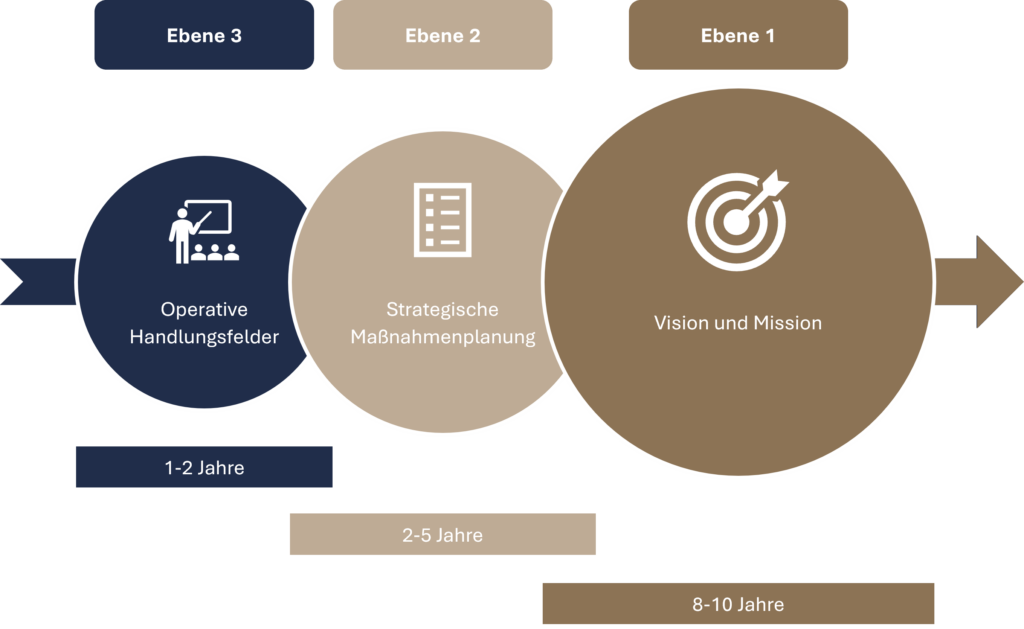Hospitals have been in perpetual crisis mode since the Covid 19 pandemic. The result is a high level of planning uncertainty, which makes consistent planning and development of a hospital strategy difficult. This blog article provides solutions on how strategy work can still succeed in stormy times.
Challenging times for hospitals
More than three years have now passed since the Covid19 pandemic began. Managing the pandemic demanded a great deal from the clinics and the people acting there.
However, after the crisis was before the crisis. This was followed by the attack on Ukraine, the energy crisis and still persistently high inflation. Last but not least, the upcoming hospital reform will keep the hospital landscape additionally on its toes in the coming years.
Times of crisis are usually accompanied by a very high level of uncertainty. The turbulence of the past few months has further increased the economic pressure on hospitals considerably. This means that an increasing number of insolvencies can also be expected. It seems that there is currently no way out of the permanent crisis mode.
What does this mean for the development of a hospital strategy? What is needed to remain capable of action even in crisis mode and not lose sight of strategic plans?
Challenges in the development and implementation of a hospital strategy
The permanent crisis mode in hospitals has shown in recent months that the half-life of a hospital strategy can be very short. Whether it’s skyrocketing costs, extraordinary staffing burdens from the Covid 19 pandemic, or the upcoming hospital formulary, they all have one thing in common: high planning uncertainty.
Instead, a high degree of flexibility, willingness to change and adaptability was and is required of the clinics.
In addition to the high level of planning uncertainty, there are two other challenges arising from the crisis mode that we can currently observe frequently in hospitals:
- The number of operational challenges, most of which have to be managed under time pressure, has increased in recent years. These include, for example, the implementation of the KHZG, the operationalization of staffing floors or the implementation of legislation from the area of data protection.
- As a result, the clinics’ “to-do” list is getting longer and longer. Smaller to medium-sized hospitals in particular, which are not integrated into a corporate structure, often lack the necessary resources, competencies and organizational structures to implement such projects efficiently and successfully.
Planning and developing a hospital strategy can therefore only work if all those involved take these challenges into account during the strategy development process and the operational fields of action are consistently considered.
Hospital strategy in the three-level model
Uncertain times call for strategic planning and implementation that leaves room for flexible action while setting a direction that everyone is willing to follow. In practice, we have found that it can be useful to look at strategy from three different levels and perspectives.
The basic idea comes from the time cone of Amy Webb (Future Today Institute), which was further developed on the basis of project experiences.
The levels each have different degrees of aggregation as well as planning horizons, which creates more flexibility.All three levels must be taken into account in the strategy development process and filled with life.
1st level: Vision and mission
Level 1 involves formulating the fundamental corporate goals in the form of a mission and vision statement. The vision statement outlines the clinic’s vision for the future and answers the “where to?” question. Why does the clinic do what and for which target group. The mission describes the day-to-day “how” the vision is to be achieved. Statements should be kept short and to the point. In uncertain times, statements can provide stability and orientation. They provide a target and can act as a compass for strategic decisions. The level of aggregation is highest here, as longer-term planning horizons still make sense at this point.
2nd level: Strategic action planning
Strategic action planning goes one level deeper and becomes more concrete. Adaptation requirements for achieving the strategy’s goals must be defined and measures derived that can be transferred into concrete planning. This includes classic strategy work, in which strategic options for action are examined and evaluated.
3rd level: Operational fields of action
In level 3, it must be examined to what extent the preconditions exist in the clinic to be able to successfully implement the strategic options. An organizational structure capable of action is needed that has the necessary competencies and resources in project management as well as in project and financial controlling in order to be able to track sustainable success in implementation. In addition, operational hurdles that may cause problems in the implementation of strategic action planning must be considered and prioritized.

The advantages of the three-level model are obvious
The three-level model has the advantage that through the vision and mission at level 1, a long-term goal picture and their daily doing towards it can be outlined. A longer planning horizon makes sense here. Due to the high level of aggregation, this offers sufficient flexibility without losing direction.
Level 2 of strategic action planning is where the classic strategy work takes place. There, the strategic options are defined and translated into an action plan. However, at 2 to 5 years, the planning horizon here is much shorter than was usual years ago.
The operational fields of action at level 3 create the basis for implementing strategic goals efficiently and consistently. A functioning operational level is imperative. This creates the necessary stability, as the 2-5 year perspective for strategic action planning is subject to the highest uncertainties. Depending on how well the hospital is already positioned, the focus in the three levels can be set differently.
Conclusion
The three-level model for strategy development and implementation does not solve the fundamental problems that clinics often lack the resources to implement the multitude of project work.
At the same time, however, it provides an approach for more structure and meaningful integration of the operational fields of action into the strategy work. Only a joint consideration allows a meaningful prioritization. The short- and medium-term planning horizons at levels 2 and 3 provide the necessary flexibility to adapt to constant change in the market.
Given the multitude of demands currently facing hospitals, this approach can provide the necessary structure to ensure a certain degree of stability even in uncertain times.
What we can do for you
We support you in planning and developing your hospital strategy by linking our management knowledge, deep market understanding and broad data base with the ideas and concepts of your employees to develop a joint strategy.
Get to know our competence area medical & location concepts.















